Mi Mix 2s Kamera Test
Xiaomi Mi Mix 2S Smartphone Review
First League. A Snapdragon 845 SoC, upwards to viii GB of RAM, a dual photographic camera organisation, and a half-dozen-inch brandish - with its first-rate equipment, the Xiaomi Mi Mix 2S enters the directly competition against the pinnacle dogs such equally the Apple iPhone 10. Our test shows whether the electric current Xiaomi flagship can actually stir up the smartphone high-cease.

With the Mi Mix 2S, the Chinese manufacturer Xiaomi sends its new 5.99-inch loftier-stop smartphone into the race. Information technology aims to convince with very proficient equipment and an elegant, almost bezel-less design. The functioning is ensured by Qualcomm's top SoC, the Snapdragon 845, and the Adreno 630 graphics unit. Both of them are hardware components that can as well exist institute in the extremely fast Sony Xperia XZ2 high-end smartphone. With this, the Xiaomi also plays in the aforementioned league in terms of performance every bit the Apple iPhone X, the Huawei P20 Pro, and the Samsung Galaxy S9+, which we therefore included every bit comparison devices in our test.
We also evaluate how the Mi Mix 2S fares compared to its sibling model, the Mi Mix 2 (without the "S"). The main difference lies in the photographic camera module. Instead of a single 12-MP sensor, the test candidate uses a 12-MP dual camera setup, which makes it the first Xiaomi smartphone to have this feature. Another argument for the Mi Mix 2S is its relatively low price. While it is not unusual that you take to pay 800 Euros (~$938) or more than for many loftier-end models, the Xiaomi (which was officially priced at 799 Euros) is already available in online shops for less than 600 Euros (~$704; starting from $630 in the US).
Brandish
5.99 inch 18:ix, 2160 10 1080 pixel 403 PPI, IPS, 81.9% screen-to-trunk ratio, Corning Gorilla Drinking glass 4, glossy: yes
Storage
128 GB UFS 2.1 Flash, 128 GB
, 116.6 GB costless
Weight
189 one thousand ( = half dozen.67 oz / 0.42 pounds), Power Supply: 45 g ( = i.59 oz / 0.one pounds)
Note: The manufacturer may employ components from dissimilar suppliers including display panels, drives or retentivity sticks with like specifications.
The Xiaomi Mi Mix 2S weighs 189 grams (~6.7 oz) and measures 150.nine ten 74.9 x 8.ane millimeters (5.94 10 2.95 x 0.32 in). It shares its elegant case design with itsXiaomi Mi Mix two sibling model, which it therefore resembles. The merely visible differences are on the fancy back embrace fabricated from shiny ceramics: While the fingerprint sensor is too placed in the centre in the Mi Mix 2S, the more powerful dual camera system has been moved to the left top corner. If you don't put the included protective comprehend around the phone, due to the camera lens slightly protruding from its case,information technology lies slightly uneven on the table.
The 5.99-inch IPS brandish, which is protected past Gorilla Drinking glass four, has a very narrow bezel measuring just a few millimeters around 3 sides and merging transitionless into the aluminum frame, making the whole smartphone look like information technology was fabricated from 1 cast and very loftier-quality. Correspondingly, the Mi Mix 2S practically cannot be twisted even with more than use of strength and leaves a very robust impression. However, due to the lack of an IP certification, it hardly offers any resistance confronting the elements.
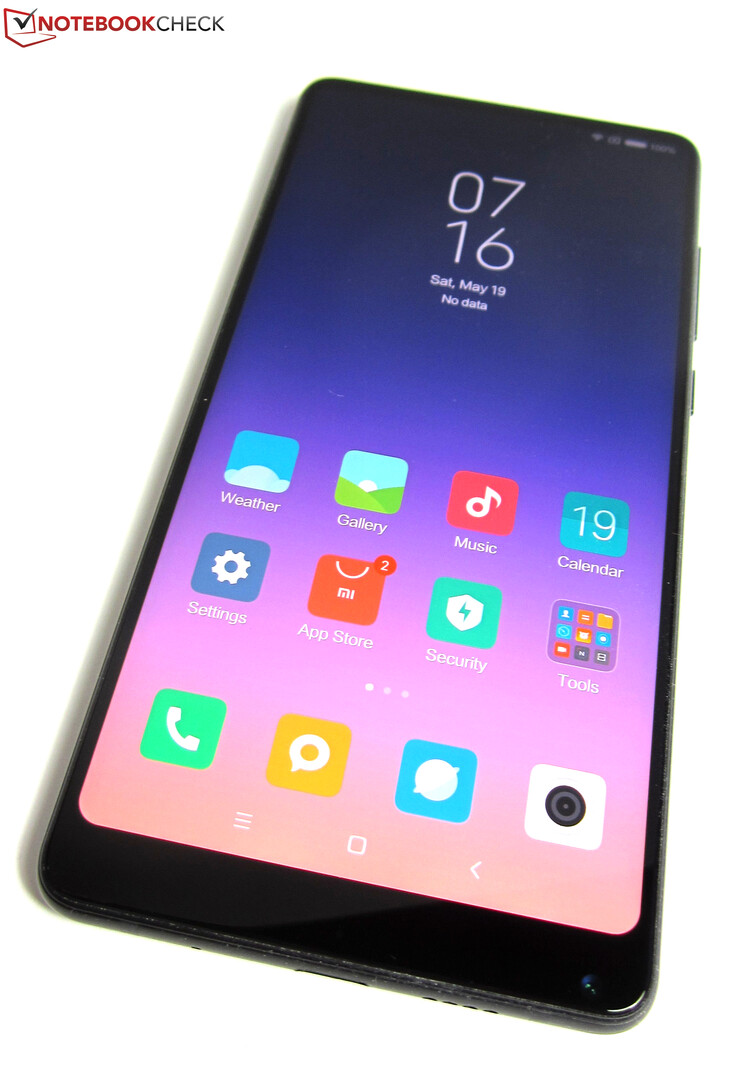
❌
Xiaomi uses the Qualcomm Snapdragon 845 high-end SoC with the Qualcomm Adreno 630 equally the GPU in the Mi Mix 2S. Depending on the version, this is combined with half dozen or eight GB of RAM and 64, 128, or 256 GB of storage. In that location is no microSD slot, then buyers should effigy out in advance which storage configuration will best fulfill their needs. On the other hand, the preinstalled ROM in our test unit of measurement used upwards relatively piddling space: Of nominally 128 GB, nearly 117 GB was still available.
The Mi Mix 2S likewise lacks a 3.five-mm sound port. However, y'all tin connect the corresponding headphones or speakers using the included USB-C adapter. The USB-C port only supports USB-2.0 speed, merely information technology supports USB-OTG, allowing you to run peripheral devices with the Xiaomi. The fingerprint sensor on the back unlocks the smartphone reliably. You lot can insert two nano-SIM cards into a tray on the left side of the smartphone.
With Android 8.0, Xiaomi has installed a very current version of the Google operating system on the Mi Mix 2S. Simply with its in-house MIUI user interface in the version 9.5, information technology is very different from a stock Android. For example, there is no app drawer, so that all the installed apps land directly on the Dwelling screen. Withal, afterwards a little time getting used to it, you tin navigate MIUI simply every bit smoothly, if not even more than intuitively, than standard Android. Various practical features such equally the gesture navigation we already know from the Apple iPhone X or the OnePlus 5T contribute to this. At that place are besides some helper functions such as "Dual Apps," which allows you to install an app twice, and so use the ii apps separately from each other. The Android security patches are on the level of Apr ane, 2018, and thus they are very current.
At the time of this test, the Xiaomi Mi Mix 2S was not available with a UI version that was customized for the High german market. For this reason, nosotros could not alter the language to German, nor was the Google Play Store preinstalled. However, the navigation did non pose whatever bug, since almost the whole user interface is in (flawless) English language and you can likewise install the Play Store after without any trouble. We only had to become used to the settings for the preinstalled Chinese apps in Chinese. Just y'all can remove them almost completely from the smartphone. In our test, we merely failed doing this with one app. Its icon shows a smiley confront, merely we have no idea what it is supposed to do, since we don't know the language.
Similar the Xiaomi Mi Mix 2, the Xiaomi Mi Mix 2S is also well-equipped for communication: In addition to Bluetooth v.0 and NFC, it too supports the LTE band 20 which is important in Germany, also equally the LTE bands ane, two, 3, 4, 5, 7, 8, 12, and 17. Due to LTE Cat. 18, the smartphone can download at speeds upward to 1.2 Gbit/s.
Things besides move fast in the WLAN. Supporting 802.11 a/b/g/n/ac and MIMO-2x2 technology, the Xiaomi Mi Mix 2S delivers a performance worthy of the high-end, when communicating with our Linksys EA8500 reference router. With 668 Mbit/south while sending data, the Chinese smartphone moves to the top of the examination field, and with 654 Mbit/s when receiving, information technology also belongs to the fastest devices. All the same, all of the devices have to line upwardly behind the Apple iPhone X here. The Xiaomi Mi Mix 2S but wins its duel with the Xiaomi Mi Mix 2 due to its slightly higher send functioning.
| Networking | |
| iperf3 transmit AX12 | |
| Xiaomi Mi Mix 2S | |
| Sony Xperia XZ2 | |
| Xiaomi Mi Mix 2 | |
| Samsung Galaxy S9 Plus | |
| Average of grade Smartphone (5.59 - 1395, n=206, concluding 2 years) | |
| Apple iPhone 10 | |
| Huawei P20 Pro | |
| iperf3 receive AX12 | |
| Apple iPhone X | |
| Sony Xperia XZ2 | |
| Xiaomi Mi Mix 2 | |
| Xiaomi Mi Mix 2S | |
| Samsung Galaxy S9 Plus | |
| Huawei P20 Pro | |
| Average of grade Smartphone (15.5 - 1348, n=206, terminal 2 years) | |
While we had to attest a few pocket-sized navigation weaknesses to the Xiaomi Mi Mix 2, the Xiaomi Mi Mix 2S did very well on our bike examination route. In the comparison with the Garmin Edge 500 professional navigation device, the smartphone fifty-fifty managed to locate u.s.a. fifty-fifty more accurately in some sections (as yous tin encounter for instance in screenshot iii, which shows the betoken where the route turns effectually).
The devices were just 20 meters apart overall, while we cannot say for sure which of the two devices gave the more accurate result. However this is withal non a depict, and the Xiaomi Mi Mix 2S wins the comparison, since it is able to determine the current position only equally accurately equally a professional person navigation device that should actually take been fifty-fifty more than authentic. This also fits with the values we determined indoors and outdoors, where the Xiaomi offered an accuracy of up to three meters.
In our examination, both sides of the phone calls with the Xiaomi Mi Mix 2S were clearly understandable, complimentary of noise, and without any drops. It was able to filter out most all the background noises and also produced a decent voice quality in speaker mode. Those who know the standard Telephone app from Android will also immediately find their way around the Xiaomi derivative: The start screen shows the number pad while the Contacts are on a second tab.

As its main camera, the Xiaomi Mi Mix 2S uses a dual photographic camera setup with a 12-MP resolution. Its principal sensor is the Sony IMX363 with 12 MP (the Mi Mix 2 uses the Sony IMX386), which is equipped with a broad-angle lens, an aperture of f/i.8, and an optical prototype stabilizer. This is combined with another sensor that also has a 12 MP resolution and enables taking pictures with a telephoto lens and an aperture of f/two.4.
The Xiaomi smartphone can record videos at a maximum resolution of 4K (3840x2178 pixels) at 30 images per second. There is no 60-FPS video mode, merely there is a slow-motion function at 1080p and 240 images per second. The webcam has a 5-MP resolution and is located at the bottom right corner, like in the Mi Mix ii. To take selfies, it is therefore best to turn the camera by 180 degrees.

Its dual cameras make the Mi Mix 2S into one of the currently best photographic camera smartphones. During daylight (scenes one and 2 in the image comparison), the 12-MP camera succeeds in taking excellent pictures that convince with natural colors and a loftier sharpness in the details. On the other hand, the video quality cannot quite keep upward with the very good photos – it is "only" a adept average. There really is only one flaw: Every bit scene iii in the prototype comparison shows, the Sony sensor hits its limits quite quickly in weak surrounding calorie-free conditions. And then some details on the images appear blurry, and some graininess sneaks into the pictures.
The camera app scores with numerous settings and filters, such as a Beauty mode, group selfies, tilt-shift recordings, and a manual mode in which you can adapt all the of import recording parameters yourself.
Prototype Comparison
Choose a scene and navigate within the first image. I click changes the position on touchscreens. One click on the zoomed-in image opens the original in a new window. The beginning prototype shows the scaled photograph of the test device.
Scene 1Scene 2Scene iii

click to load images

click to load images
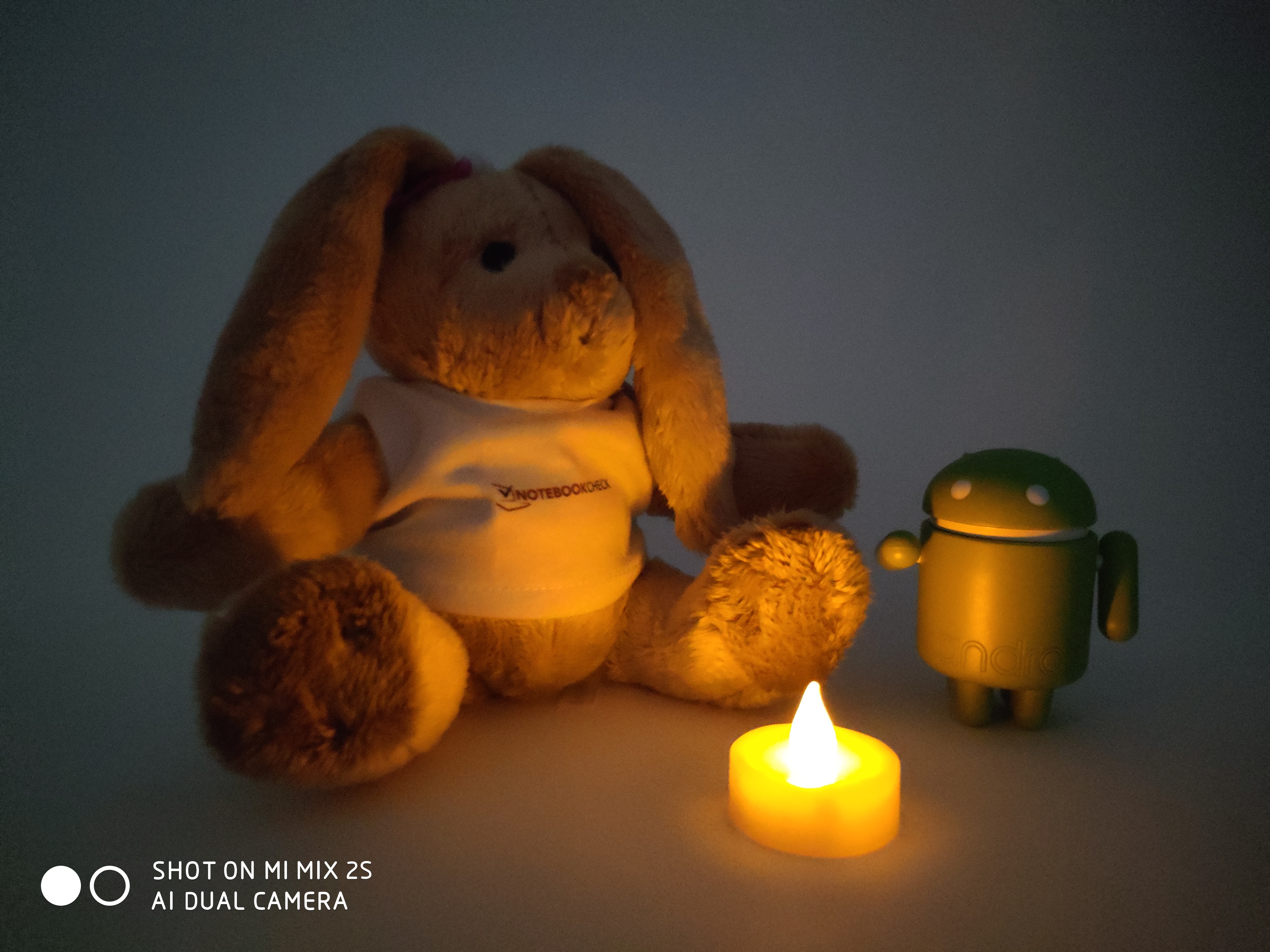
click to load images
Under controlled lite conditions in our test lab, the image of the test chart shows some slight blurriness. Overall, the light conditions here are comparable with the recordings taken in weak surrounding light: while the image continues to be good overall, we tin encounter some small imperfections in the detail view. The Mi Mix 2S records the colors on the ColorChecker examination chart slightly as well bright in general.
Xiaomi includes a modular charger (5V/3A, 5V/2A, 12V/1.5A), a USB cablevision (Type-C to Type-A), a USB-to-3.five-mm-audio adapter, a SIM tool, a protective cover, and a quick-start guide with the Mi Mix 2S. The lender of our test unit, TradingShenzen, also added an European union adapter and a USB OTG adapter.
The official Xiaomi shop offers the Mi Mix 2S with a two-year warranty. However, at the fourth dimension of our testing, the device was listed as not available yet. Alternatively, yous tin purchase it from importers such equally TradingShenzen, receiving a 1-year warranty on the smartphone in this instance. Delight see ourGuarantees, Return policies and Warranties FAQ for land-specific information.
The touchscreen of the Xiaomi Mi Mix 2S, which measures near 6-inches, reacts to inputs very accurately, no matter whether they happen in the center of the screen or the outermost edges. Supported by the fast QualcommSnapdragon 845 SoC, the smartphone implements all the commands immediately and in that location were no delays or other blunders at all. The fingerprint reader in the dorsum also reacts fast to the touch and unlocks the Mi Mix 2S reliably. The physical keys, the power push and the volume rocker, as well contribute to the high-quality overall impression. Both offering a precise force per unit area point and are set into the case without any sideways play worth mention.
Our examination unit of measurement of the Xiaomi Mi Mix 2S, which has non been localized, uses a Chinese keyboard, which can be switched to an English-language layout though. For improve operations, you tin can install an alternative keyboard such equally the Google Gboard and activate it in the system settings at any time.

The Mi Mix 2S has a 5.99-inch IPS display with a resolution of 2160x1080 pixels. This results in an 18:ix format, a screen-to-body ratio of 81.9%, and a pixel density of 403 PPI. The brandish, which is protected by Gorilla Drinking glass 4, has an average brightness of 462.7 cd/yard² and a maximum of 492 cd/m². While this corresponds to a adept effulgence, the display is not very evenly lit. However, during operation you practise not notice these minimal variations in the brightness, and neither tin can yous see private pixels on the display.
On the other manus, the blackness value of 0.59 cd/chiliad² is not quite worthy of the high-end. In a realistic, more evenly distributed brightness of the brandish (APL50), this even rises to 0.74 cd/yard². This results in a dissimilarity ratio of 834:1 in the best case, which is non bad for an IPS brandish, but it is too little in the direct comparison. The Xiaomi Mi Mix 2 sibling model does significantly better with a dissimilarity ratio of 1748:one and near of the high-cease competitors already use AMOLED displays, which theoretically achieve an indefinite dissimilarity ratio. Yet, looking at it subjectively, we constitute nothing to complain almost the display quality of the Xiaomi Mi Mix 2S; the contents are displayed with vivid colors and appear anything just banal.
Some PWM flickering occurs in the IPS display, but merely if the effulgence is reduced to 36% or lower. At 1168 Hz, the PWM frequency is very high, so that fifty-fifty a sensitive person should not feel any touch on from this.
| 463 cd/m² | 481 cd/m² | 463 cd/thou² | ||
| 447 cd/chiliad² | 492 cd/thousand² | 461 cd/m² | ||
| 447 cd/m² | 466 cd/m² | 444 cd/m² | ||
Distribution of effulgence
Ten-Rite i1Pro ii
Maximum: 492 cd/k² (Nits) Average: 462.7 cd/m² Minimum: 1.35 cd/m²
Brightness Distribution: ninety %
Centre on Battery: 492 cd/g²
Contrast: 834:1 (Black: 0.59 cd/m²)
ΔE Color 2.4 | 0.59-29.43 Ø5.3
ΔE Greyscale 4.5 | 0.64-98 Ø5.6
Gamma: 2.25
| Xiaomi Mi Mix 2S IPS, 2160x1080, 5.99 | Apple iPhone X Super AMOLED, 2436x1125, 5.80 | Huawei P20 Pro OLED, 2240x1080, 6.ten | Samsung Galaxy S9 Plus Super AMOLED, 2960x1440, 6.20 | Sony Xperia XZ2 IPS, 2160x1080, 5.70 | Xiaomi Mi Mix ii IPS, 2160x1080, half dozen.00 | |
|---|---|---|---|---|---|---|
| Screen | 37% | 37% | 22% | 36% | 15% | |
| Effulgence heart | 492 | 600 22% | 569 16% | 565 15% | 630 28% | 472 -4% |
| Effulgence | 463 | 606 31% | 578 25% | 571 23% | 632 37% | 430 -7% |
| Brightness Distribution | 90 | 94 4% | 95 6% | 96 vii% | 96 vii% | 87 -3% |
| Black Level * | 0.59 | 0.44 25% | 0.27 54% | |||
| Dissimilarity | 834 | 1432 72% | 1748 110% | |||
| Colorchecker dE 2000 * | 2.4 | 1.2 50% | 1.iii 46% | 2.3 4% | i.5 37% | iii.five -46% |
| Colorchecker dE 2000 max. * | 6.two | 3 52% | 2.1 66% | four.8 23% | four.three 31% | v.9 5% |
| Greyscale dE 2000 * | 4.5 | ane.6 64% | 1.6 64% | 1.9 58% | ii.1 53% | four 11% |
| Gamma | ii.25 98% | 2.23 99% | 2.31 95% | 2.16 102% | two.17 101% | 2.29 96% |
| CCT | 6395 102% | 6707 97% | 6401 102% | 6332 103% | 6513 100% | 7048 92% |
* ... smaller is ameliorate
Screen Flickering / PWM (Pulse-Width Modulation)
ℹ
To dim the screen, some notebooks will simply cycle the backlight on and off in rapid succession - a method called Pulse Width Modulation (PWM) . This cycling frequency should ideally be undetectable to the human heart. If said frequency is too low, users with sensitive eyes may feel strain or headaches or even notice the flickering altogether.
| Screen flickering / PWM detected | 1168 Hz | ≤ 36 % brightness setting | 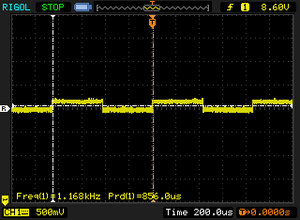 |
| The display backlight flickers at 1168 Hz (Likely utilizing PWM) Flickering detected at a brightness setting of 36 % and below. At that place should be no flickering or PWM above this brightness setting. The frequency of 1168 Hz is quite high, so virtually users sensitive to PWM should not find any flickering. In comparison: 52 % of all tested devices practise not utilize PWM to dim the display. If PWM was detected, an average of 21723 (minimum: 5 - maximum: 3846000) Hz was measured. | |||
Display Response Times
ℹ
Display response times prove how fast the screen is able to change from one color to the next. Irksome response times can lead to afterimages and tin can crusade moving objects to appear blurry (ghosting). Gamers of fast-paced 3D titles should pay special attention to fast response times.
| ↔ Response Fourth dimension Black to White | ||
|---|---|---|
| 25.4 ms ... rising ↗ and autumn ↘ combined | ↗ 7.6 ms rise | 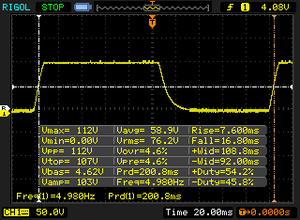 |
| ↘ 16.8 ms fall | ||
| The screen shows relatively slow response rates in our tests and may be too slow for gamers. In comparison, all tested devices range from 0.viii (minimum) to 240 (maximum) ms. » 49 % of all devices are amend. This means that the measured response time is similar to the average of all tested devices (23.3 ms). | ||
| ↔ Response Fourth dimension 50% Gray to lxxx% Grayness | ||
| 56 ms ... ascension ↗ and fall ↘ combined | ↗ 27.6 ms rise | 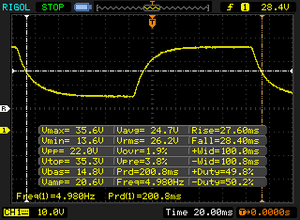 |
| ↘ 28.iv ms fall | ||
| The screen shows slow response rates in our tests and will exist unsatisfactory for gamers. In comparison, all tested devices range from 0.692 (minimum) to 636 (maximum) ms. » 90 % of all devices are better. This ways that the measured response time is worse than the boilerplate of all tested devices (36.7 ms). | ||
You lot tin activate various settings for the colour reproduction in the display options, which nosotros evaluate with the CalMAN software and the spectral photometer. For the colors, yous can select from the "Default," "Warm," and "Absurd" modes and for the contrast from "Automatic Contrast," "Increased Contrast," and "Standard." Y'all get the best color reproduction with the combination "Default" and "Standard." According to CalMAN, the color deviations are lowest and so, and at a Delta-E value of 2.4, they are fifty-fifty within the platonic range (Delta-Due east < 3).
Due to its high brightness reserves, the Xiaomi Mi Mix 2S fifty-fifty fares well outdoors and is able to flexibly adapt to varying light conditions using its quick-reacting brightness sensor. As is typical for an IPS display, the viewing-angle stability is good from all viewing angles, and there are no changes in the colors or brightness worth mention, fifty-fifty when looking from very steep viewing angles.
With the Qualcomm Snapdragon 845, the Xiaomi Mi Mix 2S uses a current high-end SoC, combining it with the QualcommAdreno 630 GPU that plays in the same performance league. Supported by at least six GB of RAM (alternatively, the smartphone is likewise available with 8 GB), the Xiaomi smartphone develops a considerable corporeality of power, leaving the slightly weaker equipped, but by no ways slow,Xiaomi Mi Mix two conspicuously behind. Overall, it is head to head with the residue of the comparison devices and even beats the Apple iPhone X in some of the synthetic benchmarks.
Similar to a car that cannot quite bring its full performance onto the route when its wheels are spinning, the performance of the Xiaomi smartphone is non e'er fully used, due to the throttling that starts early on (see the corresponding test section). A expert example for this is the computing-intensive 3DMark tests which run for quite a long fourth dimension. Because the Xiaomi smartphone repeatedly ran into the throttling limitation there, it nigh always achieved slightly lower results than the Sony Xperia XZ2 that is equipped with the same SoC. But this is of course nitpicking at a high level: The slight difference in the benchmark results will definitely take no noticeable upshot in everyday usage, and despite some throttling interventions, the Xiaomi Mi Mix 2S is and will always be an extremely fast smartphone.
| AnTuTu v6 - Total Score (sort by value) | |
| Xiaomi Mi Mix 2S | |
| Apple iPhone 10 | |
| Huawei P20 Pro | |
| Samsung Milky way S9 Plus | |
| Sony Xperia XZ2 | |
| Average Qualcomm Snapdragon 845 (162183 - 242953, northward=23) | |
| AnTuTu v7 - Total Score (sort by value) | |
| Xiaomi Mi Mix 2S | |
| Apple tree iPhone X | |
| Huawei P20 Pro | |
| Samsung Milky way S9 Plus | |
| Sony Xperia XZ2 | |
| Xiaomi Mi Mix ii | |
| Average Qualcomm Snapdragon 845 (246366 - 299878, due north=27) | |
| PCMark for Android | |
| Piece of work operation score (sort by value) | |
| Xiaomi Mi Mix 2S | |
| Huawei P20 Pro | |
| Samsung Galaxy S9 Plus | |
| Sony Xperia XZ2 | |
| Xiaomi Mi Mix 2 | |
| Boilerplate Qualcomm Snapdragon 845 (7998 - 13211, due north=26) | |
| Average of grade Smartphone (3341 - 19989, n=96, last ii years) | |
| Work 2.0 functioning score (sort past value) | |
| Xiaomi Mi Mix 2S | |
| Huawei P20 Pro | |
| Samsung Galaxy S9 Plus | |
| Sony Xperia XZ2 | |
| Xiaomi Mi Mix 2 | |
| Average Qualcomm Snapdragon 845 (7360 - 9868, northward=27) | |
| Average of class Smartphone (82 - 15299, n=143, final two years) | |
| BaseMark Os II | |
| Overall (sort by value) | |
| Xiaomi Mi Mix 2S | |
| Apple tree iPhone Ten | |
| Huawei P20 Pro | |
| Samsung Galaxy S9 Plus | |
| Sony Xperia XZ2 | |
| Xiaomi Mi Mix 2 | |
| Average Qualcomm Snapdragon 845 (3291 - 4693, northward=26) | |
| Average of course Smartphone (895 - 8753, north=174, last two years) | |
| System (sort by value) | |
| Xiaomi Mi Mix 2S | |
| Apple iPhone X | |
| Huawei P20 Pro | |
| Samsung Galaxy S9 Plus | |
| Sony Xperia XZ2 | |
| Xiaomi Mi Mix 2 | |
| Boilerplate Qualcomm Snapdragon 845 (4417 - 8613, n=26) | |
| Average of class Smartphone (1542 - 19657, n=174, final two years) | |
| Retentiveness (sort by value) | |
| Xiaomi Mi Mix 2S | |
| Apple iPhone 10 | |
| Huawei P20 Pro | |
| Samsung Milky way S9 Plus | |
| Sony Xperia XZ2 | |
| Xiaomi Mi Mix 2 | |
| Average Qualcomm Snapdragon 845 (2193 - 5296, n=26) | |
| Average of course Smartphone (1012 - 9044, north=174, terminal 2 years) | |
| Graphics (sort by value) | |
| Xiaomi Mi Mix 2S | |
| Apple iPhone X | |
| Huawei P20 Pro | |
| Samsung Galaxy S9 Plus | |
| Sony Xperia XZ2 | |
| Xiaomi Mi Mix 2 | |
| Average Qualcomm Snapdragon 845 (5846 - 8001, n=26) | |
| Average of course Smartphone (478 - 26660, n=174, last 2 years) | |
| Spider web (sort by value) | |
| Xiaomi Mi Mix 2S | |
| Apple iPhone 10 | |
| Huawei P20 Pro | |
| Samsung Galaxy S9 Plus | |
| Sony Xperia XZ2 | |
| Xiaomi Mi Mix two | |
| Boilerplate Qualcomm Snapdragon 845 (1009 - 1613, n=26) | |
| Boilerplate of class Smartphone (718 - 2392, northward=174, last two years) | |
| Geekbench 4.one - 4.4 | |
| 64 Bit Single-Core Score (sort by value) | |
| Xiaomi Mi Mix 2S | |
| Apple tree iPhone X | |
| Huawei P20 Pro | |
| Samsung Galaxy S9 Plus | |
| Sony Xperia XZ2 | |
| Xiaomi Mi Mix 2 | |
| Average Qualcomm Snapdragon 845 (2272 - 2500, n=27) | |
| Average of form Smartphone (711 - 6994, due north=64, last 2 years) | |
| 64 Scrap Multi-Core Score (sort by value) | |
| Xiaomi Mi Mix 2S | |
| Apple iPhone X | |
| Huawei P20 Pro | |
| Samsung Milky way S9 Plus | |
| Sony Xperia XZ2 | |
| Xiaomi Mi Mix 2 | |
| Boilerplate Qualcomm Snapdragon 845 (7754 - 9231, due north=27) | |
| Average of grade Smartphone (3574 - 16777, due north=64, last 2 years) | |
| Compute RenderScript Score (sort by value) | |
| Huawei P20 Pro | |
| Samsung Galaxy S9 Plus | |
| Sony Xperia XZ2 | |
| Xiaomi Mi Mix 2 | |
| Average Qualcomm Snapdragon 845 (10876 - 14489, n=25) | |
| Average of grade Smartphone (2810 - 11667, n=49, last two years) | |
| 3DMark | |
| 1280x720 offscreen Ice Storm Unlimited Score (sort by value) | |
| Xiaomi Mi Mix 2S | |
| Apple tree iPhone X | |
| Huawei P20 Pro | |
| Samsung Galaxy S9 Plus | |
| Sony Xperia XZ2 | |
| Xiaomi Mi Mix 2 | |
| Boilerplate Qualcomm Snapdragon 845 (34855 - 65330, n=27) | |
| Average of class Smartphone (2920 - 117606, northward=83, last 2 years) | |
| 1280x720 offscreen Water ice Storm Unlimited Graphics Score (sort by value) | |
| Xiaomi Mi Mix 2S | |
| Apple tree iPhone X | |
| Huawei P20 Pro | |
| Samsung Galaxy S9 Plus | |
| Sony Xperia XZ2 | |
| Xiaomi Mi Mix 2 | |
| Boilerplate Qualcomm Snapdragon 845 (53794 - 85487, n=27) | |
| Average of class Smartphone (2463 - 224130, due north=83, terminal 2 years) | |
| 1280x720 offscreen Ice Storm Unlimited Physics (sort past value) | |
| Xiaomi Mi Mix 2S | |
| Apple iPhone X | |
| Huawei P20 Pro | |
| Samsung Galaxy S9 Plus | |
| Sony Xperia XZ2 | |
| Xiaomi Mi Mix 2 | |
| Average Qualcomm Snapdragon 845 (15614 - 37475, northward=27) | |
| Average of class Smartphone (8324 - 59268, n=83, last 2 years) | |
| 2560x1440 Sling Shot OpenGL ES three.0 (sort past value) | |
| Xiaomi Mi Mix 2S | |
| Huawei P20 Pro | |
| Samsung Galaxy S9 Plus | |
| Sony Xperia XZ2 | |
| Xiaomi Mi Mix ii | |
| Average Qualcomm Snapdragon 845 (4363 - 6454, due north=27) | |
| Boilerplate of grade Smartphone (68 - 11256, n=178, last 2 years) | |
| 2560x1440 Sling Shot OpenGL ES 3.0 Graphics (sort by value) | |
| Xiaomi Mi Mix 2S | |
| Huawei P20 Pro | |
| Samsung Galaxy S9 Plus | |
| Sony Xperia XZ2 | |
| Xiaomi Mi Mix ii | |
| Average Qualcomm Snapdragon 845 (5637 - 8312, due north=27) | |
| Average of course Smartphone (54 - 16670, n=178, final two years) | |
| 2560x1440 Sling Shot OpenGL ES three.0 Physics (sort by value) | |
| Xiaomi Mi Mix 2S | |
| Huawei P20 Pro | |
| Samsung Galaxy S9 Plus | |
| Sony Xperia XZ2 | |
| Xiaomi Mi Mix 2 | |
| Boilerplate Qualcomm Snapdragon 845 (2124 - 3668, n=27) | |
| Average of class Smartphone (677 - 5301, n=178, last 2 years) | |
| 2560x1440 Sling Shot Farthermost (ES 3.one) (sort by value) | |
| Xiaomi Mi Mix 2S | |
| Apple iPhone X | |
| Huawei P20 Pro | |
| Samsung Milky way S9 Plus | |
| Sony Xperia XZ2 | |
| Xiaomi Mi Mix 2 | |
| Boilerplate Qualcomm Snapdragon 845 (3197 - 4734, n=27) | |
| Average of class Smartphone (78 - 9138, n=180, final 2 years) | |
| 2560x1440 Sling Shot Extreme (ES 3.1) Graphics (sort past value) | |
| Xiaomi Mi Mix 2S | |
| Apple iPhone X | |
| Huawei P20 Pro | |
| Samsung Galaxy S9 Plus | |
| Sony Xperia XZ2 | |
| Xiaomi Mi Mix 2 | |
| Average Qualcomm Snapdragon 845 (3488 - 5246, n=27) | |
| Average of course Smartphone (62 - 11573, n=179, last two years) | |
| 2560x1440 Sling Shot Extreme (ES 3.1) Physics (sort by value) | |
| Xiaomi Mi Mix 2S | |
| Apple iPhone X | |
| Huawei P20 Pro | |
| Samsung Galaxy S9 Plus | |
| Sony Xperia XZ2 | |
| Xiaomi Mi Mix two | |
| Average Qualcomm Snapdragon 845 (2118 - 3703, n=27) | |
| Average of class Smartphone (688 - 5318, n=179, terminal ii years) | |
| GFXBench (DX / GLBenchmark) 2.seven | |
| T-Male monarch Onscreen (sort by value) | |
| Xiaomi Mi Mix 2S | |
| Apple tree iPhone X | |
| Huawei P20 Pro | |
| Samsung Galaxy S9 Plus | |
| Sony Xperia XZ2 | |
| Xiaomi Mi Mix 2 | |
| Average Qualcomm Snapdragon 845 (58 - 89, n=27) | |
| Average of grade Smartphone (9.5 - 165, n=200, last 2 years) | |
| 1920x1080 T-Rex Offscreen (sort by value) | |
| Xiaomi Mi Mix 2S | |
| Apple iPhone X | |
| Huawei P20 Pro | |
| Samsung Galaxy S9 Plus | |
| Sony Xperia XZ2 | |
| Xiaomi Mi Mix two | |
| Average Qualcomm Snapdragon 845 (98 - 152, n=28) | |
| Average of class Smartphone (6 - 439, n=200, last two years) | |
| GFXBench three.0 | |
| on screen Manhattan Onscreen OGL (sort by value) | |
| Xiaomi Mi Mix 2S | |
| Apple iPhone X | |
| Huawei P20 Pro | |
| Samsung Milky way S9 Plus | |
| Sony Xperia XZ2 | |
| Xiaomi Mi Mix 2 | |
| Average Qualcomm Snapdragon 845 (33 - 75, north=27) | |
| Average of form Smartphone (four.five - 161, n=199, last 2 years) | |
| 1920x1080 1080p Manhattan Offscreen (sort by value) | |
| Xiaomi Mi Mix 2S | |
| Apple iPhone 10 | |
| Huawei P20 Pro | |
| Samsung Milky way S9 Plus | |
| Sony Xperia XZ2 | |
| Xiaomi Mi Mix 2 | |
| Average Qualcomm Snapdragon 845 (54 - 83, north=27) | |
| Average of class Smartphone (2.iv - 251, n=200, last ii years) | |
| GFXBench 3.1 | |
| on screen Manhattan ES 3.1 Onscreen (sort past value) | |
| Xiaomi Mi Mix 2S | |
| Apple iPhone X | |
| Huawei P20 Pro | |
| Samsung Galaxy S9 Plus | |
| Sony Xperia XZ2 | |
| Xiaomi Mi Mix 2 | |
| Average Qualcomm Snapdragon 845 (21 - 59, n=27) | |
| Average of class Smartphone (3.1 - 136, northward=199, last two years) | |
| 1920x1080 Manhattan ES 3.1 Offscreen (sort past value) | |
| Xiaomi Mi Mix 2S | |
| Apple tree iPhone X | |
| Huawei P20 Pro | |
| Samsung Galaxy S9 Plus | |
| Sony Xperia XZ2 | |
| Xiaomi Mi Mix 2 | |
| Average Qualcomm Snapdragon 845 (32 - 61, due north=28) | |
| Average of class Smartphone (ane.4 - 173, due north=200, last 2 years) | |
| GFXBench | |
| on screen Car Chase Onscreen (sort by value) | |
| Xiaomi Mi Mix 2S | |
| Apple iPhone 10 | |
| Huawei P20 Pro | |
| Samsung Galaxy S9 Plus | |
| Sony Xperia XZ2 | |
| Xiaomi Mi Mix 2 | |
| Average Qualcomm Snapdragon 845 (13 - 37, due north=27) | |
| Boilerplate of class Smartphone (3.3 - 83, n=199, last 2 years) | |
| 1920x1080 Car Hunt Offscreen (sort by value) | |
| Xiaomi Mi Mix 2S | |
| Apple iPhone X | |
| Huawei P20 Pro | |
| Samsung Galaxy S9 Plus | |
| Sony Xperia XZ2 | |
| Xiaomi Mi Mix ii | |
| Boilerplate Qualcomm Snapdragon 845 (25 - 35, n=27) | |
| Average of course Smartphone (1.eight - 102, n=199, last 2 years) | |
Legend
Xiaomi Mi Mix 2S Qualcomm Snapdragon 845, Qualcomm Adreno 630, 128 GB UFS 2.1 Flash
Apple iPhone 10 Apple A11 Bionic, Apple tree A11 Bionic GPU, 64 GB eMMC Wink
Huawei P20 Pro HiSilicon Kirin 970, ARM Republic of mali-G72 MP12, 128 GB UFS 2.ane Wink
Sony Xperia XZ2 Qualcomm Snapdragon 845, Qualcomm Adreno 630, 64 GB UFS 2.1 Wink
Xiaomi Mi Mix ii Qualcomm Snapdragon 835 (8998), Qualcomm Adreno 540, 64 GB eMMC Flash
While the Xiaomi Mi Mix 2S is non quite able to achieve the performance of the Sony Xperia XZ2 and much less the Apple iPhone X in the browser benchmarks, the overall issue is more than respectable despite that. Demanding websites are rendered smoothly, and fast surfing is guaranteed.
| JetStream 1.ane - Full Score | |
| Apple iPhone Ten (IOS 11.one.1) | |
| Average of course Smartphone (ten.8 - 414, n=167, final two years) | |
| Sony Xperia XZ2 (Chrome 65) | |
| Boilerplate Qualcomm Snapdragon 845 (22.5 - 90.nine, n=25) | |
| Xiaomi Mi Mix 2S (Chrome 66.0.3359.158) | |
| Samsung Milky way S9 Plus (Samsung Browser vii.0) | |
| Huawei P20 Pro (Chrome 65) | |
| Octane V2 - Full Score | |
| Apple iPhone Ten (IOS 11.1.ii) | |
| Boilerplate of grade Smartphone (3526 - 65969, n=189, last 2 years) | |
| Sony Xperia XZ2 (Chrome 65) | |
| Average Qualcomm Snapdragon 845 (3991 - 18275, northward=28) | |
| Samsung Milky way S9 Plus (Samsung Browser seven.0) | |
| Xiaomi Mi Mix 2S (Chrome 66.0.3359.158) | |
| Huawei P20 Pro (Chrome 65) | |
| Xiaomi Mi Mix two (Chrome 53) | |
| Mozilla Kraken 1.i - Total Score | |
| Huawei P20 Pro (Chrome 65) | |
| Average of class Smartphone (414 - 15230, n=187, last ii years) | |
| Average Qualcomm Snapdragon 845 (2154 - 11204, n=28) | |
| Xiaomi Mi Mix 2S (Chrome 66.0.3359.158) | |
| Xiaomi Mi Mix 2 (Chrome 53) | |
| Sony Xperia XZ2 (Chrome 65) | |
| Samsung Milky way S9 Plus (Samsung Browser 7.0) | |
| Apple iPhone X (IOS 11.ane.2) | |
| WebXPRT 2015 - Overall Score | |
| Apple iPhone X (Safari Mobile eleven.0) | |
| Sony Xperia XZ2 (Chrome 65) | |
| Average Qualcomm Snapdragon 845 (96 - 291, due north=23) | |
| Xiaomi Mi Mix 2S (Chrome 66.0.3359.158) | |
| Huawei P20 Pro (Chrome 65) | |
| Samsung Milky way S9 Plus (Samsung Browser 7.0) | |
| Xiaomi Mi Mix 2 (Chrome 53) | |
* ... smaller is amend
Every bit information technology should be for a high-finish smartphone, inside the Xiaomi Mi Mix 2S is a fast UFS-2.1 storage module, which is attested elevation values by Androbench. Only the Huawei P20 Pro is even a tick faster. While the Xiaomi Mi Mix ii is almost always head to caput with our test unit, due to its below-average 4-KB random reads, information technology does not have a chance.
| Xiaomi Mi Mix 2S | Huawei P20 Pro | Samsung Galaxy S9 Plus | Sony Xperia XZ2 | Xiaomi Mi Mix two | Boilerplate 128 GB UFS 2.1 Flash | Average of class Smartphone | |
|---|---|---|---|---|---|---|---|
| AndroBench three-5 | 9% | -xx% | -23% | -21% | 13% | 54% | |
| Sequential Read 256KB | 756 | 832 10% | 819 8% | 679 -10% | 704 -seven% | 772 ? 2% | 952 ? 26% |
| Sequential Write 256KB | 208.1 | 196.7 -5% | 204.9 -2% | 198.7 -5% | 208.half dozen 0% | 286 ? 37% | 491 ? 136% |
| Random Read 4KB | 135.1 | 144.iii 7% | 129.vii -4% | 149.4 11% | 148.5 10% | 149.four ? 11% | 169.ix ? 26% |
| Random Write 4KB | 128.4 | 160.five 25% | 22.74 -82% | 17 -87% | 15.75 -88% | 128.4 ? 0% | 165.2 ? 29% |
The Xiaomi Mi Mix 2S accelerates games with its Adreno 630 high-end GPU, managing to bring even graphically very demanding games such equally Loonshit of Valor or PUBG Mobile smoothly to its IPS display. Subjectively, all the tested games ran butter-smooth. Unfortunatelyat this point, we are unable to ostend this with hard facts, i.eastward., frame rates, since the smartphone could non exist convinced to establish a connexion to the Gamebench examination app. Regardless of this, due to its powerful SoC, the Mi Mix 2S is definitely a hereafter-proof investment for gamers.
During performance, the Xiaomi Mi Mix 2S hardly heats up. Taking the measurements on the front and back together results in a comfortable, manus-warm boilerplate temperature of 34.vii °C (94 °F) during idle. It does not go much warmer during load. Fifty-fifty after an hour-long stress test, the temperatures do not rising above 40.6 °C (105 °F).
However, underneath the hood, not everything remains as calm. If you claiming the Xiaomi Mi Mix 2S sufficiently, it rapidly reacts with throttling. While the high-end smartphone still remains unfazed by the T-Rex test scenario of GFXBench, since this demands relatively little computing power, things look different in the significantly more hardware-intensive Manhattan test scenario. Already after a fifth of a full of thirty runs with the same game scene rendered each time, the functioning drops considerably and and then remains on a lower level until the end.
| |||||||||||||||||||||||||
| Maximum: 40.6 °C = 105 F Average: 39.four °C = 103 F | |||||||||||||||||||||||||
| |||||||||||||||||||||||||
| Maximum: 36.9 °C = 98 F Average: 35.two °C = 95 F | |||||||||||||||||||||||||
Ability Supply (max.) 34.one °C = 93 F | Room Temperature 22 °C = 72 F | Voltcraft IR-260
| |||||||||||||||||||||||||
| Maximum: 39 °C = 102 F Average: 36 °C = 97 F | |||||||||||||||||||||||||
| |||||||||||||||||||||||||
| Maximum: 33.7 °C = 93 F Boilerplate: 33.3 °C = 92 F | |||||||||||||||||||||||||
Power Supply (max.) 34.1 °C = 93 F | Room Temperature 22 °C = 72 F | Voltcraft IR-260
(-) The average temperature for the upper side nether maximal load is 39.4 °C / 103 F, compared to the boilerplate of 32.8 °C / 91 F for the devices in the class Smartphone.
(±) The maximum temperature on the upper side is 40.6 °C / 105 F, compared to the average of 35.1 °C / 95 F, ranging from 22 to 52.9 °C for the class Smartphone.
(+) The bottom heats up to a maximum of 36.ix °C / 98 F, compared to the boilerplate of 33.8 °C / 93 F
(±) In idle usage, the boilerplate temperature for the upper side is 36 °C / 97 F, compared to the device boilerplate of 32.8 °C / 91 F.
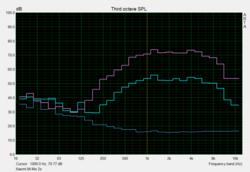
With its mono speaker positioned at the bottom edge, the Xiaomi Mi Mix 2S produces a solid sound for a smartphone. While the small audio membrane can produce a volume up to 83.1 dB(A), some bass is lacking. As expected, information technology sounds a lot better when you lot connect headphones to the included USB adapter. Not only will yous then be rewarded with a stereo sound, but also with a much fuller audio spectrum.
Frequency diagram (checkboxes can be checked and unchecked to compare devices)
Xiaomi Mi Mix 2S sound analysis
(+) | speakers tin can play relatively loud (83.1 dB)
Bass 100 - 315 Hz
(-) | nearly no bass - on average 26% lower than median
(±) | linearity of bass is average (9.2% delta to prev. frequency)
Mids 400 - 2000 Hz
(+) | balanced mids - only iv% away from median
(+) | mids are linear (v.one% delta to prev. frequency)
Highs 2 - 16 kHz
(+) | balanced highs - only 3% away from median
(+) | highs are linear (3.4% delta to prev. frequency)
Overall 100 - xvi.000 Hz
(±) | linearity of overall sound is average (20% difference to median)
Compared to same class
» 23% of all tested devices in this class were improve, x% similar, 67% worse
» The best had a delta of 12%, average was 23%, worst was 65%
Compared to all devices tested
» 49% of all tested devices were better, 9% similar, 42% worse
» The all-time had a delta of iii%, average was 20%, worst was 65%
Xiaomi Mi Mix 2 sound analysis
(+) | speakers can play relatively loud (86.6 dB)
Bass 100 - 315 Hz
(-) | most no bass - on average 29.v% lower than median
(±) | linearity of bass is average (11.2% delta to prev. frequency)
Mids 400 - 2000 Hz
(±) | higher mids - on average five.1% higher than median
(+) | mids are linear (5.3% delta to prev. frequency)
Highs 2 - 16 kHz
(±) | higher highs - on boilerplate 7.four% higher than median
(+) | highs are linear (5.2% delta to prev. frequency)
Overall 100 - 16.000 Hz
(±) | linearity of overall sound is average (26% difference to median)
Compared to same form
» 70% of all tested devices in this class were better, 8% similar, 22% worse
» The best had a delta of 12%, boilerplate was 23%, worst was 65%
Compared to all devices tested
» 82% of all tested devices were ameliorate, 4% similar, 14% worse
» The best had a delta of three%, boilerplate was 20%, worst was 65%
Huawei P20 Pro audio analysis
(+) | speakers can play relatively loud (84.9 dB)
Bass 100 - 315 Hz
(-) | nearly no bass - on average 21% lower than median
(±) | linearity of bass is average (9.five% delta to prev. frequency)
Mids 400 - 2000 Hz
(±) | college mids - on boilerplate 5% higher than median
(±) | linearity of mids is average (7.2% delta to prev. frequency)
Highs 2 - 16 kHz
(±) | higher highs - on boilerplate 5.half dozen% college than median
(+) | highs are linear (4.five% delta to prev. frequency)
Overall 100 - 16.000 Hz
(±) | linearity of overall sound is boilerplate (19.vii% departure to median)
Compared to aforementioned class
» 21% of all tested devices in this class were improve, 9% similar, 70% worse
» The best had a delta of 12%, average was 23%, worst was 65%
Compared to all devices tested
» 48% of all tested devices were better, seven% similar, 45% worse
» The best had a delta of 3%, boilerplate was twenty%, worst was 65%
With a power consumption of 2.25 watts on average during idle and four.89 watts under load, the Mi Mix 2S almost exactly hits the boilerplate of all the smartphones we tested that had the Snapdragon-845 SoC, and so it delivers a solid performance that lets united states promise for a solid battery life. All the same, the Xiaomi Mi Mix 2 sibling model sets the bar quite high here, since it runs slightly more free energy efficient overall and besides brings the larger battery.
| Xiaomi Mi Mix 2S 3400 mAh | Apple iPhone 10 2716 mAh | Huawei P20 Pro 4000 mAh | Samsung Galaxy S9 Plus 3500 mAh | Sony Xperia XZ2 3180 mAh | Xiaomi Mi Mix 2 3771 mAh | Average Qualcomm Snapdragon 845 | Average of class Smartphone | |
|---|---|---|---|---|---|---|---|---|
| Ability Consumption | 2% | 35% | 34% | 3% | 14% | 4% | eleven% | |
| Idle Minimum * | 0.75 | 1.03 -37% | 0.84 -12% | 0.68 9% | 0.72 four% | 0.69 8% | 0.862 ? -15% | 0.905 ? -21% |
| Idle Average * | ii.25 | ii.four -7% | 1.54 32% | 0.95 58% | ii.21 two% | ii.03 10% | one.728 ? 23% | one.66 ? 26% |
| Idle Maximum * | 2.26 | 2.half-dozen -15% | 1.57 31% | 1.09 52% | ii.22 two% | two.1 7% | two.07 ? viii% | one.886 ? 17% |
| Load Average * | 4.89 | 2.96 39% | 2.47 49% | 4.58 six% | 4.six 6% | 3.18 35% | iv.87 ? -0% | 4.47 ? nine% |
| Load Maximum * | 9.six | 6.six 31% | 2.49 74% | 5.xvi 46% | ix.34 3% | 8.73 9% | 9.27 ? three% | 7.32 ? 24% |
* ... smaller is meliorate
The good results in the power consumption are reflected in a battery life that is but as skilful. In the 2 benchmarks that come closest to everyday operation, which are surfing on the web and playing an H.264 video at a display effulgence adjusted to 150 cd/chiliad², the Xiaomi Mi Mix 2S lasts for about 12 hours each fourth dimension. This is enough to beat almost all of the competitors. Simply the Huawei P20 Pro achieves an fifty-fifty improve battery life overall.
In addition to the inductive Qi, the Mi Mix 2S too supports Qualcomm Quick Charge three.0. With the latter, the smartphone is fully recharged afterwards virtually 1.five hours, if y'all use the included charger (5V/3A, 5V/2A, 12V/1.5A).
Battery Runtime
| Idle (without WLAN, min effulgence) | 27h 58min | |
| WiFi Websurfing | 11h 56min | |
| Big Buck Bunny H.264 1080p | 11h 58min | |
| Load (maximum brightness) | 3h 59min |
Pros
+ very fast SoC
+ loftier-quality case
+ dual-SIM
+ USB-C
+ Android 8.0 with intuitive MIUI 9.5 user interface
+ brilliant brandish
+ very good dual cameras
+ not much heat development
+ good bombardment life
+ protective cover included
Cons
- USB-C only at 2.0 speeds
- no IP certification
- no microSD slot
- 3.5-mm headset connection only via USB-C adapter
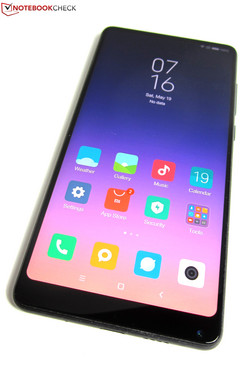
Only like the Xiaomi Mi Mix ii, the Xiaomi Mi Mix 2S has no weaknesses worth mentioning. The workmanship of the 5.99-inch Android smartphone is first-form, the display shows a razor-precipitous image of the contents, the dual camera setup belongs to the currently all-time smartphone cameras, and the advice modules hardly leave anything to be desired either. Furthermore, with the Snapdragon 845 in that location is a lightning-fast SoC, making the operation of the Mi Mix 2S amazingly smooth. While Android 8.0, which has been jazzed upwardly via MIUI 9.five, is slightly different in its layout from a stock Android, information technology can exist navigated at least just as intuitively and in addition offers a couple of practical extras.
There are simply a few negative points with the current Xiaomi flagship: The USB-C port can just handle USB-2.0 speeds, and at that place is no microSD slot. You can supersede the lacking 3.5-mm headset port by using the included USB adapter. In contrast to many of the high-end rivals, the Mi Mix 2S does not have IP certification, and so it is neither protected from grit nor h2o. Those who receive the Xiaomi as an import from People's republic of china, similar nosotros did, have to install Google Play, which is not actually a disadvantage since it tin exist done quickly.
A successful feat: With its powerful overall performance, the Xiaomi Mi Mix 2S recommends itself every bit a good alternative to high-end smartphones such as the Apple iPhone Ten, Huawei P20 Pro, or Samsung Galaxy S9+.
Xiaomi Mi Mix 2S - 2018-05-22 05/22/2018 v6(sometime)
Manuel Masiero
Smartphone - Weighted Boilerplate
Pricecompare

My fascination for computers started with the C64. Since then, I've put everything that comes my way in terms of hardware through its paces. From the C64 to the Amiga 500 and the first PC with an 8088 CPU, my listing of projects has grown increasingly longer. For more than twenty years now I take too turned my hobby into my profession and have been active in the mobile section of Notebookcheck since 2021. Earlier that, I worked as a hardware editor for IDG Media (tecChannel.de) and VNU Business Publications (PC professional person), amongst others.
Manuel Masiero, 2018-05-28 (Update: 2020-05-19)
Source: https://www.notebookcheck.net/Xiaomi-Mi-Mix-2S-Smartphone-Review.305878.0.html
Posted by: williamscollas.blogspot.com

0 Response to "Mi Mix 2s Kamera Test"
Post a Comment